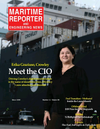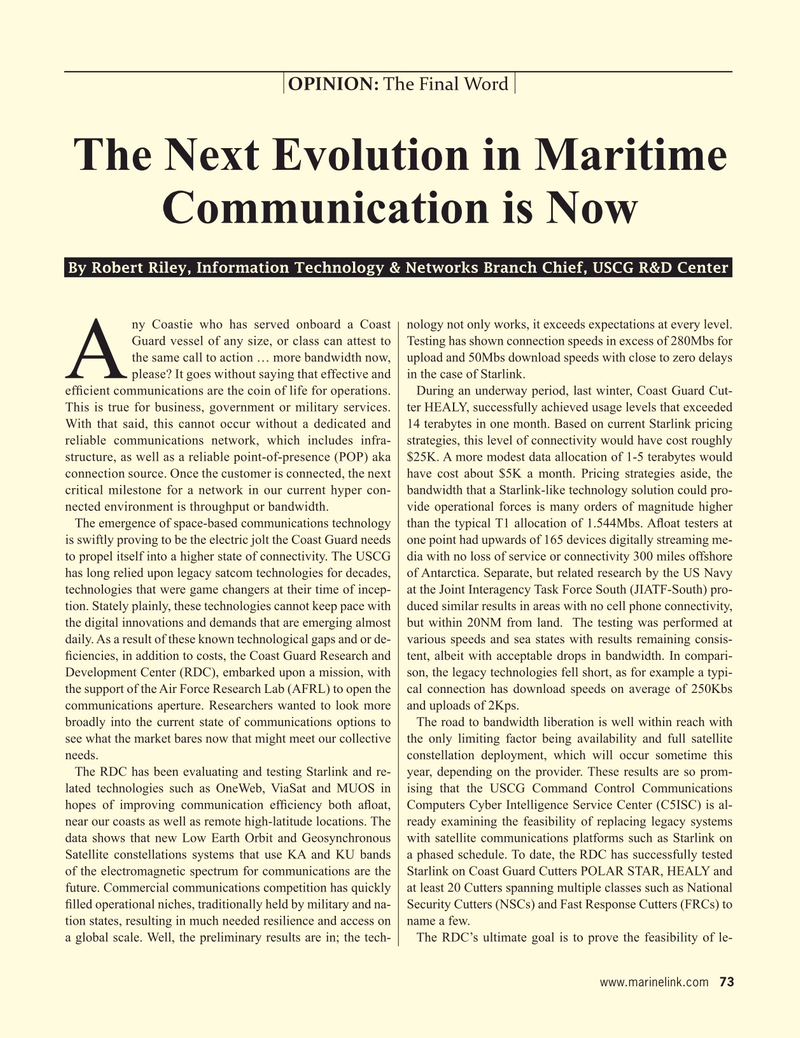
Page 73: of Maritime Reporter Magazine (November 2023)
Workboat Edition
Read this page in Pdf, Flash or Html5 edition of November 2023 Maritime Reporter Magazine
OPINION: The Final Word
The Next Evolution in Maritime
Communication is Now
By Robert Riley, Information Technology & Networks Branch Chief, USCG R&D Center ny Coastie who has served onboard a Coast nology not only works, it exceeds expectations at every level.
Guard vessel of any size, or class can attest to Testing has shown connection speeds in excess of 280Mbs for the same call to action … more bandwidth now, upload and 50Mbs download speeds with close to zero delays
A please? It goes without saying that effective and in the case of Starlink.
ef? cient communications are the coin of life for operations. During an underway period, last winter, Coast Guard Cut-
This is true for business, government or military services. ter HEALY, successfully achieved usage levels that exceeded
With that said, this cannot occur without a dedicated and 14 terabytes in one month. Based on current Starlink pricing reliable communications network, which includes infra- strategies, this level of connectivity would have cost roughly structure, as well as a reliable point-of-presence (POP) aka $25K. A more modest data allocation of 1-5 terabytes would connection source. Once the customer is connected, the next have cost about $5K a month. Pricing strategies aside, the critical milestone for a network in our current hyper con- bandwidth that a Starlink-like technology solution could pro- nected environment is throughput or bandwidth. vide operational forces is many orders of magnitude higher
The emergence of space-based communications technology than the typical T1 allocation of 1.544Mbs. A? oat testers at is swiftly proving to be the electric jolt the Coast Guard needs one point had upwards of 165 devices digitally streaming me- to propel itself into a higher state of connectivity. The USCG dia with no loss of service or connectivity 300 miles offshore has long relied upon legacy satcom technologies for decades, of Antarctica. Separate, but related research by the US Navy technologies that were game changers at their time of incep- at the Joint Interagency Task Force South (JIATF-South) pro- tion. Stately plainly, these technologies cannot keep pace with duced similar results in areas with no cell phone connectivity, the digital innovations and demands that are emerging almost but within 20NM from land. The testing was performed at daily. As a result of these known technological gaps and or de- various speeds and sea states with results remaining consis- ? ciencies, in addition to costs, the Coast Guard Research and tent, albeit with acceptable drops in bandwidth. In compari-
Development Center (RDC), embarked upon a mission, with son, the legacy technologies fell short, as for example a typi- the support of the Air Force Research Lab (AFRL) to open the cal connection has download speeds on average of 250Kbs communications aperture. Researchers wanted to look more and uploads of 2Kps. broadly into the current state of communications options to The road to bandwidth liberation is well within reach with see what the market bares now that might meet our collective the only limiting factor being availability and full satellite needs. constellation deployment, which will occur sometime this
The RDC has been evaluating and testing Starlink and re- year, depending on the provider. These results are so prom- lated technologies such as OneWeb, ViaSat and MUOS in ising that the USCG Command Control Communications hopes of improving communication ef? ciency both a? oat, Computers Cyber Intelligence Service Center (C5ISC) is al- near our coasts as well as remote high-latitude locations. The ready examining the feasibility of replacing legacy systems data shows that new Low Earth Orbit and Geosynchronous with satellite communications platforms such as Starlink on
Satellite constellations systems that use KA and KU bands a phased schedule. To date, the RDC has successfully tested of the electromagnetic spectrum for communications are the Starlink on Coast Guard Cutters POLAR STAR, HEALY and future. Commercial communications competition has quickly at least 20 Cutters spanning multiple classes such as National ? lled operational niches, traditionally held by military and na- Security Cutters (NSCs) and Fast Response Cutters (FRCs) to tion states, resulting in much needed resilience and access on name a few. a global scale. Well, the preliminary results are in; the tech- The RDC’s ultimate goal is to prove the feasibility of le- www.marinelink.com 73
MR #11 (66-75).indd 73 11/7/2023 5:09:46 PM

 72
72

 74
74
